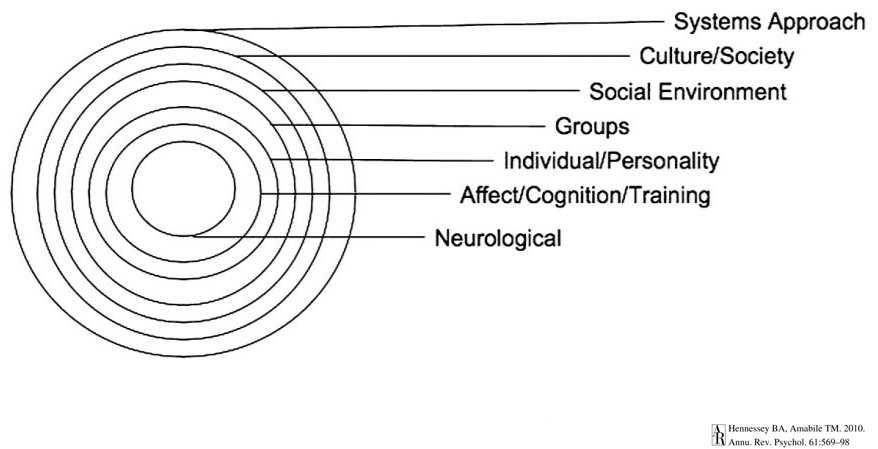“Most of the things that are interesting, important, and human are the result of creativity.” –Mihaly Csikszentmihalyi (here)
Creativity emerges through multiple levels and interdisciplinary observation. The simplified model below presents the main levels of which creativity occurs, where it is noticeable that the creative process cross-levels of cultures, societies, religious and other environment groups.
Showing that the dimension of creativity today is more dependent on the whole system and conditions we offer, rather than being dependent on one talented individual.
As mentioned above creativity depends on the current environment, time and who is judging the ‘criteria’. Let’s start first with defining a creative person. Should we call a creative person an individual who has bright, unusual brilliant thoughts or the one that has natural ability to deliver creative task or even the talented individual that has brilliant ideas plus talent? Csikszentmihalyi is convinced that creative person does not need to be either brilliant or talented. It needs to have an impact. This means that needs to have an ability to revolutionise the culture in a way to bring a change to the society that will benefit in a long run.
“Creative individuals are remarkable for their ability to adapt to almost any situation and to make do with whatever is at hand to reach their goals.” (here)
When talking about the creativity and leadership it is important for the organisations to understand that it is unavoidable to sustain the company, especially at the early stage and after the business reaches global scale with the right creative management. The experiment at Harvard Business School, where they invite top leaders from creative companies concluded that “…there is a role for management in the creative process; it is just different from what the traditional work of management might suggest.” (Aamabile, Khaire, 2008). Therefore, in order to enhance the creativity in the organisation, it is important to not manage creativity but manage for creativity. To achieve this a leader should encourage employees to contribute imagination and not give a task to an employee to just execute it, as it can be seen in traditional management such as top-down strategy as managers are not the one that has ‘ownership’ of that idea. According to Amabile “…the greatest success come from workers’ own initiatives.” (Aamabile, Khaire, 2008), which shows that the biggest reward for the employees comes from their contribution to organisational network and not by being managed in a traditional way.
Through the research of analysing people in creative paths, it has been shown how many time the creative ideas comes from the teams where people has different backgrounds, skills and knowledge. This presents another valid point to consider when encouraging creativity in the organisation.
Regarding the creative individual traits, Aamabile and Khaire (2008) describes that individuals that are coming from multiple social backgrounds, such as being both Asian and American give person different social identity, which allows individual to have various of knowledge and being comfortable with incorporating that knowledge into everyday life. The experiment has shown that when solving creative problems those people had more innovative ideas. “If managers cause people to suppress parts of their identity, they limit a potentially valuable source of creativity.” (Aamabile, Khaire, 2008). Sir Ken Robinson agrees when saying in his talk at London Business forum that creative leader is not somebody who would tell people what to do, instead to create the conditions and culture where everybody could share their ideas, meaning being themselves.
To sums it up, organisations who want to sustain their position or start-ups that just started their venture should implement creative leadership and change that traditional management to creative leadership that will allow all the valuable creative minds within the organisations to be able to bring out their best creative ideas for the benefit of all.
How Society Kills Your Creativity, An Award-Winning Pixar-short movie representing how suppressing the creativity can have harmful consequences.









